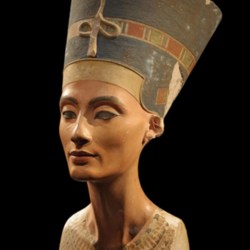Bust of Nefertiti
Title
Bust of Nefertiti
Date
c. 1340 BC, 18th Dynasty, under the rule of Pharaoh Akhenaten
Artist or Workshop
Unknown (occasionally credited to Thutmose)
Materials
Painted limestone with gypsum plaster layers, wax with rock crystal inlay (in eye)
Height of the work
47-48 cm tall
Provenience
Amarna, Egypt, found in the Thutmose workshop
Current Location
The Neues Museum of Berlin, Germany
Description and Significance
Description: The Bust of Nefertiti, a highly significant bust from the New Kingdom (18th Dynasty, Amarna Period) showcases Queen Nefertiti holding her head in an upright position. Her eyes are half open, rendering a sense of serenity, and her mouth indicates a hint of a smile. Furthermore, she is depicted with heavily idealized features; her face is slender, her cheekbones are highly protruding, and her face is one of great symmetry. Her features are heavily accentuated, indicating the type of makeup which was common for women of her ranking in Ancient Egypt; her lips are colored a reddish brown and her eyes are outlined in deep black lines. Her neck is long and elegant, and she is decorated quite ornately, with a collar of jewels resting on her chest and a tall, cylindrical, painted headdress atop her head. It is predominately painted in a dark blue with a ribbon-like decoration depicted in gold, green, and lighter blue. Upon the center of the headdress, uraeus was applied atop the surface vertically and painted with gold paint. This significant snake as well as her left ear are both heavily damaged today. Her skin is a dark ruddy color and the artist created shadows to depict heavy contour in her face and neck.
Significance: Much like Hatshepsut, Queen Nefertiti is rendered with some male characteristics; for instance, her skin is of a reddish color, which is how men were normally portrayed to illustrate their fortitude and work in the outdoors. This has huge significance because it indicates that she was powerful in ways that men were and likely non-subservient at a time when women were meant to act solely as support systems for men; these typically-male characteristics signify that she had privileges that perhaps other women of her time did not have access to. Otherwise, she is clearly female based on her makeup and and feminine facial features (and elongated neck). Her ornamentations also signify power and status along with great wealth. The depiction of uraeus upon her headdress represents her royalty. The Bust of Nefertiti remains highly significant based on her poise and grace as well as the depiction strength in her womanhood. Additionally, much of Nefertiti’s significance stems from what art historians deem to have been her function. Nefertiti was found in the cupboard of the workshop of Thutmose, a sculptor from the Amarna Period. This location, as well as the fact that only one of her eyes was prepared to be inlaid with precious stones, indicate that this bust was used for teaching purposes within the workshop. Furthermore, the fact there is simply a bust with no body attached enhances the likeliness of this theory as well. The Bust of Nefertiti serves as one of the most well-known pieces from antiquity, yet may have been a mere teaching tool within its day and age.
Significance: Much like Hatshepsut, Queen Nefertiti is rendered with some male characteristics; for instance, her skin is of a reddish color, which is how men were normally portrayed to illustrate their fortitude and work in the outdoors. This has huge significance because it indicates that she was powerful in ways that men were and likely non-subservient at a time when women were meant to act solely as support systems for men; these typically-male characteristics signify that she had privileges that perhaps other women of her time did not have access to. Otherwise, she is clearly female based on her makeup and and feminine facial features (and elongated neck). Her ornamentations also signify power and status along with great wealth. The depiction of uraeus upon her headdress represents her royalty. The Bust of Nefertiti remains highly significant based on her poise and grace as well as the depiction strength in her womanhood. Additionally, much of Nefertiti’s significance stems from what art historians deem to have been her function. Nefertiti was found in the cupboard of the workshop of Thutmose, a sculptor from the Amarna Period. This location, as well as the fact that only one of her eyes was prepared to be inlaid with precious stones, indicate that this bust was used for teaching purposes within the workshop. Furthermore, the fact there is simply a bust with no body attached enhances the likeliness of this theory as well. The Bust of Nefertiti serves as one of the most well-known pieces from antiquity, yet may have been a mere teaching tool within its day and age.
References
Neues Museum: http://www.smb.museum/en/museums-institutions/neues-museum/home.html
Khan Academy: https://www.khanacademy.org/humanities/ancient-art-civilizations/egypt-art/new-kingdom/v/thutmose-bust-of-nefertiti-c-1340-bce
Ascaso, Francisco J., et al. "One eyed beauty: Queen Nefertiti's bust." British Journal of Ophthalmology 95.2 (2011): 161-161.
Arnold, Dorothea. The royal women of Amarna: images of beauty from ancient Egypt. Metropolitan Museum of Art, 1996. Pages 52-70.
Khan Academy: https://www.khanacademy.org/humanities/ancient-art-civilizations/egypt-art/new-kingdom/v/thutmose-bust-of-nefertiti-c-1340-bce
Ascaso, Francisco J., et al. "One eyed beauty: Queen Nefertiti's bust." British Journal of Ophthalmology 95.2 (2011): 161-161.
Arnold, Dorothea. The royal women of Amarna: images of beauty from ancient Egypt. Metropolitan Museum of Art, 1996. Pages 52-70.
Contributor
Charlotte Myers
Citation
Unknown (occasionally credited to Thutmose), “Bust of Nefertiti,” Digital Portrait "Basket" - ARTH488A "Ancient Mediterranean Portraiture", accessed June 6, 2025, http://classicalchopped.artinterp.org/omeka/items/show/4.
Item Relations
This item has no relations.

